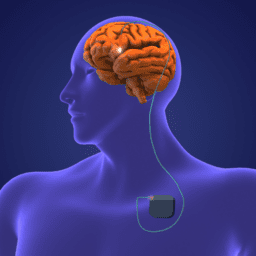At the Davis Phinney Foundation, our Parkinson’s research program is uniquely focused on improving quality of life. Annually, we partner with leading researchers and institutions to fund quality of life research that shows promise to help change how people live with Parkinson’s. This year, we are excited to announce the newest study funded by our Quality of Life Research Program: Exercise in Advanced Parkinson’s with Deep Brain Stimulation.
Exercise in Advanced Parkinson’s with Deep Brain Stimulation
This project will be a three-month prospective study assessing the immediate and long-term changes associated with aerobic exercise in quality-of-life measures in people with Parkinson’s who have undergone deep brain stimulation (DBS) for management of their symptoms. More specifically, the study aims to assess the feasibility of an aerobic exercise regimen in people with advanced Parkinson’s and DBS, to characterize the immediate and long-term changes in neuronal activity with exercise in Parkinson’s, and to assess the non-motor impact of exercise in individuals with advanced Parkinson’s and DBS.
The study will recruit individuals who are not regular exercisers and develop an individualized three-month exercise plan with the assistance of physical therapists, using heart rate targets for moderate exercise. Outcomes will be measured at baseline and following three months of regular exercise.
Several studies have demonstrated the benefit of cardiovascular exercise in those with Parkinson’s (Schenkman, Hall et al. 2012). There are both motor and non-motor benefits as well as consideration of possible disease-modifying benefits in early Parkinson’s (Ahlskog 2011, Palasz, Niewiadomski et al. 2019). However, studies on exercise in advanced Parkinson’s are limited, and there is no published literature related to exercise in those with DBS for Parkinson’s.
DBS has significant benefit from a motor perspective, but its effects on non-motor symptoms of Parkinson’s is an evolving field without clearly understood outcomes. This project will help determine whether exercise is feasible in more advanced Parkinson’s, its impact on non-motor parkinsonian symptoms, and whether there is benefit in quality of life with incorporating exercise in later stages of Parkinson’s.
Furthermore, the proposal says, because novel technology allows researchers to easily assess field potentials of the neural tissue in the basal ganglia, the team will have “an unprecedented opportunity to safely monitor neuronal changes in the brain in real time.”
This research award was made possible, in part, by a generous gift from the Don and Janet Doles Giving Fund.
The research team
- Sana Aslam, DO. Principal Investigator. Barrow Neurological Institute, Muhammad Ali Parkinson’s Center, Neurology Department
- Holly Shill, MD. Co-Investigator. Barrow Neurological Institute, Muhammad Ali Parkinson’s Center, Neurology Department
- Francisco Ponce, MD. Co-Investigator. Barrow Neurological Institute, Neurosurgery Department
- Bradley Greger, PhD. Co-Investigator. Associate Professor, School of Biological & Health Systems Engineering, Arizona State University
- Ashley Guest, MD/PhD Candidate. Co-Investigator. Neural Engineering Lab. University of Arizona College of Medicine – Phoenix
- Balthazar Zavala, MD. Co-Investigator. Barrow Neurological Institute, Muhammad Ali Parkinson’s Center, Neurosurgery Department
Get involved
If you are interested in participating in this study, please reach out to Dr. Sana Aslam at sana.aslam@barrowneuro.org.
Learn More about our Quality of Life Research Program
Guided by our Science Advisory Board, the Davis Phinney Foundation has supported more than 30 research studies focused on exercise, nutrition, gait, speech, telemedicine, alternative therapies, and other interventions that affect quality of life. Many of these studies have progressed to late-stage clinical research. Others have gone on to receive NIH and PCORI funding. And others have become therapies that are being used today by people living with Parkinson’s. To learn more about these projects and our research program, click here.

















